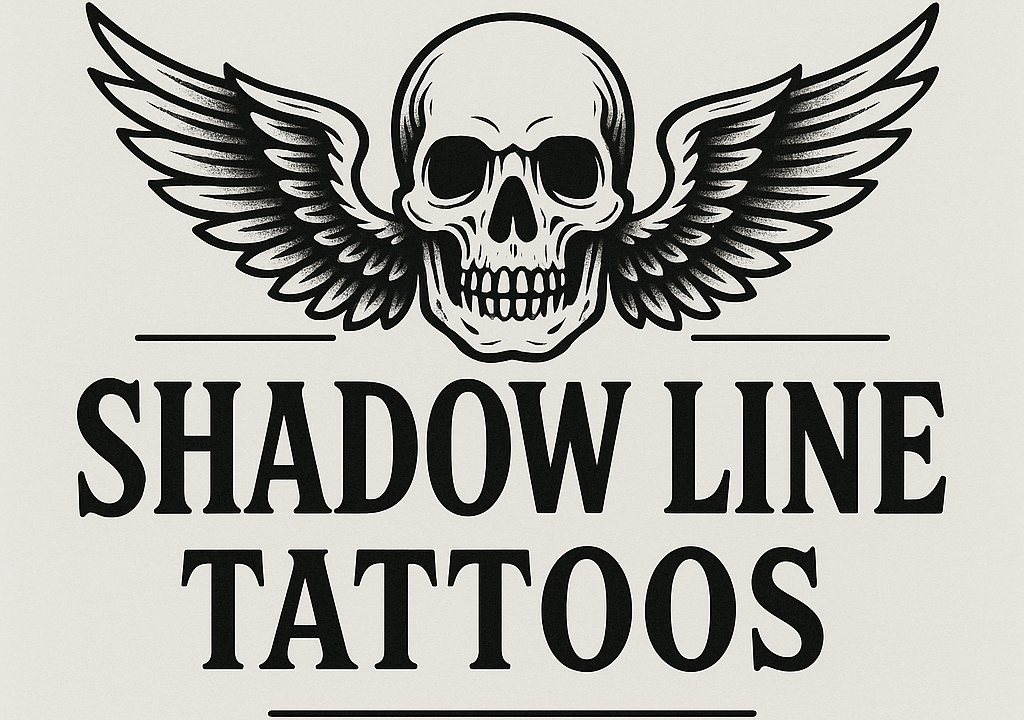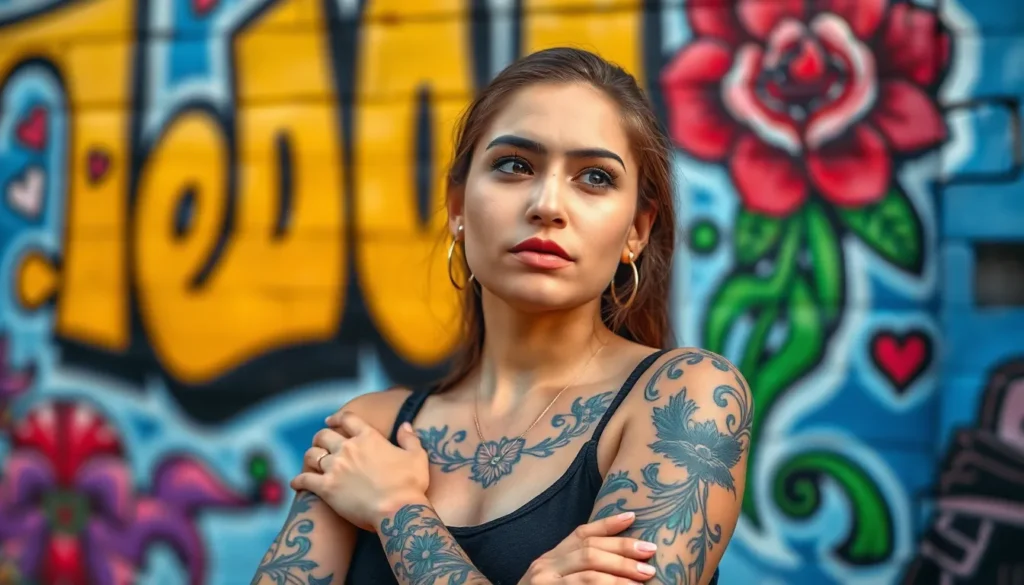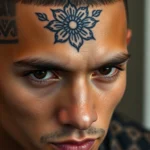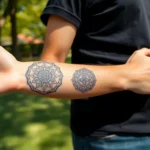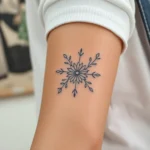Pain is a universal human experience that shapes who we become. Whether it’s physical emotional or psychological pain leaves its mark on our souls. That’s why pain tattoo ideas have become increasingly popular among those seeking to transform their struggles into meaningful body art.
We’ve all faced moments that tested our limits and changed our perspective on life. These experiences deserve recognition and what better way to honor them than through carefully chosen tattoo designs? Pain-inspired tattoos serve as permanent reminders of our resilience and the strength we’ve gained through difficult times.
From symbolic representations of overcoming addiction to artistic interpretations of loss and healing these tattoos tell powerful stories. They’re not just ink on skin – they’re declarations of survival triumph and personal growth that resonate with anyone who’s walked through the fire and emerged stronger.
Symbolic Pain Tattoo Designs That Tell Your Story
Symbolic tattoos transform our deepest struggles into visual narratives that speak without words. These meaningful designs capture the essence of our pain while celebrating our journey toward healing.
Broken Heart Imagery
Broken heart tattoos represent the universal experience of emotional devastation and lost love. We often see these designs featuring jagged cracks, shattered pieces, or hearts split down the middle to symbolize the fracturing of trust and intimacy. Popular variations include hearts with bandages, stitches, or surgical staples that represent the healing process after betrayal or loss.
Artists frequently incorporate dripping elements like blood or tears to emphasize the raw emotion behind heartbreak. Some clients choose anatomically correct hearts with visible breaks, while others prefer stylized cartoon hearts with lightning bolt cracks. These tattoos serve as permanent acknowledgments of our capacity to love deeply, even when that love brings profound pain.
Thorns and Roses Combinations
Thorns and roses create powerful metaphors for beauty emerging from suffering and the duality of life’s experiences. We choose these designs to represent how our most beautiful growth often comes from our most painful moments. The contrast between delicate rose petals and sharp thorns perfectly captures the complexity of human resilience.
Common interpretations include roses blooming through barbed wire, thorny vines wrapping around meaningful dates, or single roses with prominently featured thorns. Many people select red roses to symbolize passionate love that caused pain, while black roses often represent grief or loss. The placement of thorns can vary from subtle accents to dominant features that overshadow the bloom.
Anatomical Heart with Scars
Anatomical heart tattoos with visible scars showcase our emotional wounds with medical precision and artistic beauty. We see these designs featuring realistic heart anatomy complete with chambers, arteries, and veins, marked by various types of scarring. Surgical scars, keloid formations, and stitch marks transform the heart into a survivor’s badge of honor.
These tattoos often include additional elements like EKG lines, medical instruments, or prescription bottles to represent mental health struggles or physical ailments. Some designs incorporate dates of important trauma, names of lost loved ones, or quotes about healing directly into the scar tissue. The anatomical accuracy combined with scar imagery creates a powerful statement about our body’s ability to continue functioning even though damage.
Abstract Pain Representation Tattoo Concepts
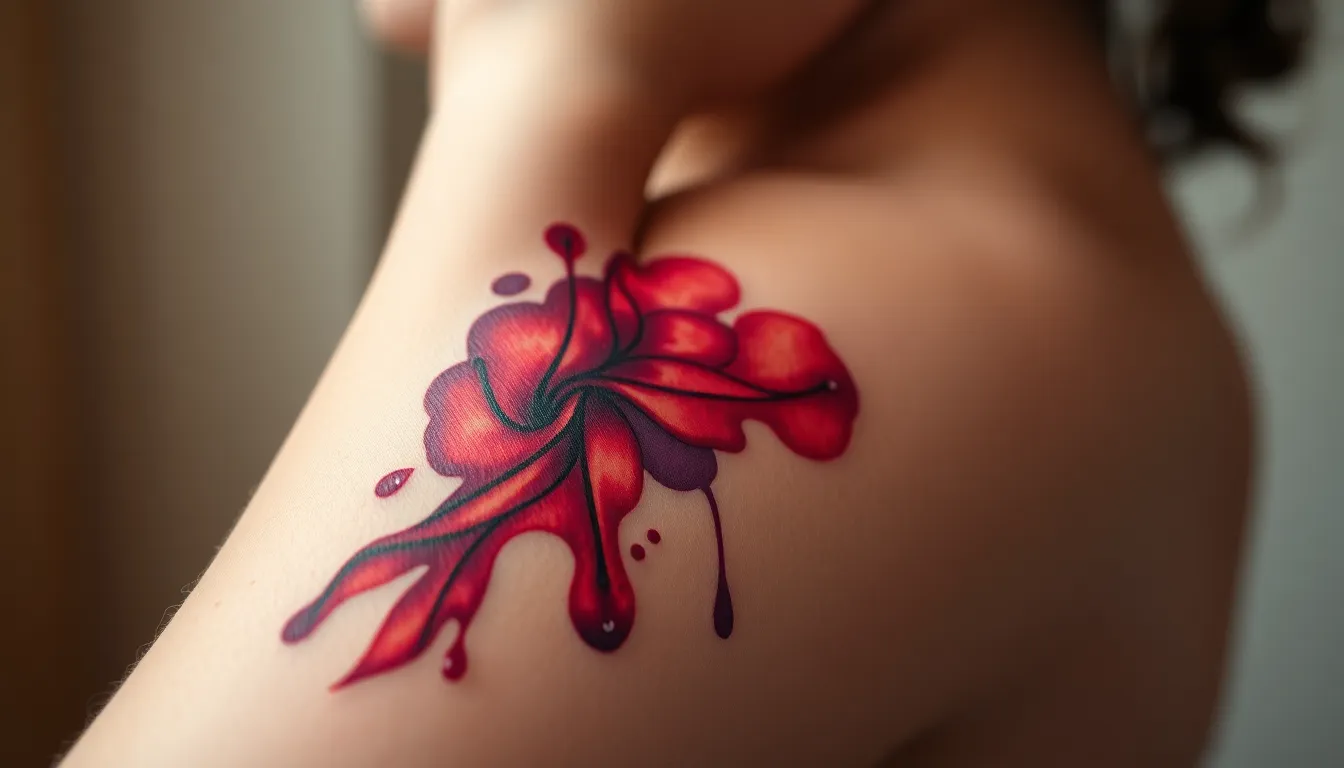
We can express emotional suffering through artistic interpretations that move beyond literal symbols. These conceptual designs transform internal struggles into flowing, ever-changing artwork that captures the essence of pain without depicting it directly.
Watercolor Bleeding Effects
Watercolor bleeding effects create powerful representations of emotional pain through their fluid, uncontrolled nature. These tattoos use blended colors that flow and merge together, symbolizing how emotional wounds spread and affect different aspects of our lives. The technique mimics actual bleeding, where ink appears to seep beyond defined boundaries, representing the way trauma often extends beyond its initial impact.
Artists typically incorporate deep reds, purples, and blues that gradually fade into lighter tones, creating a visual representation of pain intensity diminishing over time. The unpredictable nature of watercolor bleeding mirrors how we can’t always control our emotional responses to difficult experiences. Research shows that tattoos can serve as embodied pain, where the physical tattooing process becomes linked to psychological healing.
Shattered Glass Patterns
Shattered glass patterns symbolize the breaking of emotional barriers and the fragmentation of our inner selves during difficult times. These geometric designs feature sharp, angular lines that radiate outward from a central point, representing how a single traumatic event can create multiple fractures in our psyche. The interconnected cracks show how different aspects of our lives become affected by emotional damage.
We often see these tattoos incorporating reflective elements or negative space to enhance the glass effect. The pattern can represent both destruction and the potential for reconstruction, as shattered glass can be reformed into something new and beautiful. Many people choose this design to commemorate moments when they felt completely broken but eventually found ways to piece themselves back together.
Storm Cloud Formations
Storm cloud formations capture the turbulence and intensity of emotional upheaval through dramatic, swirling patterns. These designs typically feature dark, heavy clouds with ever-changing movement lines that suggest powerful winds and internal turmoil. The contrast between light and shadow in these tattoos represents the way emotional storms can both obscure our vision and eventually clear to reveal new perspectives.
Lightning elements often accompany storm clouds, symbolizing sudden realizations or moments of clarity that emerge from chaotic periods. The temporary nature of storms makes this design particularly meaningful for those who’ve weathered emotional difficulties and emerged stronger. Studies indicate that tattoo placement affects pain levels during the process, with areas near bone being more sensitive, which can add symbolic meaning to storm cloud tattoos placed in these locations.
Literary and Quote-Based Pain Tattoo Ideas

Words carry tremendous power to capture our deepest struggles and transform them into permanent reminders of strength. Literature offers countless expressions of pain that resonate with our personal journeys through hardship.
Meaningful Pain-Related Quotes
“Pain nourishes courage” stands as one of the most powerful short tattoo phrases we encounter. This quote emphasizes how our suffering directly feeds our ability to face future challenges with greater strength.
“With pain comes strength” serves as another compelling reminder that struggles lead to personal growth. We often see this tattooed in elegant script fonts across ribs or forearms where it’s easily visible during difficult moments.
“Let your joy scream across the pain” encourages finding happiness even though adversity. This longer quote works beautifully as a wraparound design on arms or thighs, creating a visual journey from darkness to light.
“Pain is inevitable” highlights the universal truth that suffering touches every life. We appreciate how this simple statement acknowledges our shared human experience while offering comfort through its honesty.
Poetry Excerpts About Suffering
“The industry breaks everyone, and afterward, many are strong at the broken places” comes from Ernest Hemingway’s “A Farewell to Arms.” This profound line reflects on the resilience that follows suffering, making it ideal for larger tattoo pieces across the back or chest.
“One must still have chaos in oneself to give birth to a dancing star” originates from Friedrich Nietzsche’s philosophical works. We find this quote particularly meaningful as it suggests that internal turmoil can lead to beautiful transformation and creative expression.
Poetry excerpts work exceptionally well in flowing script fonts that mirror the original rhythm of the verse. These longer pieces often incorporate decorative elements like flourishes or small symbolic icons that complement the text’s meaning.
Book References to Overcoming Hardship
“The Nightingale” by Kristin Hannah touches on themes of enduring pain during wartime struggles. We recommend incorporating subtle bird imagery alongside quotes from this novel to create layered symbolism representing freedom and survival.
“The Alchemist” by Paulo Coelho explores overcoming obstacles while pursuing one’s dreams even though adversity. Quotes from this beloved book pair beautifully with compass roses or desert imagery to represent the journey through hardship.
Book references offer rich opportunities for combining text with visual elements that represent the story’s themes. We suggest choosing shorter, impactful phrases rather than lengthy passages to maintain the tattoo’s visual clarity and emotional impact.
Memorial Pain Tattoo Designs for Lost Loved Ones
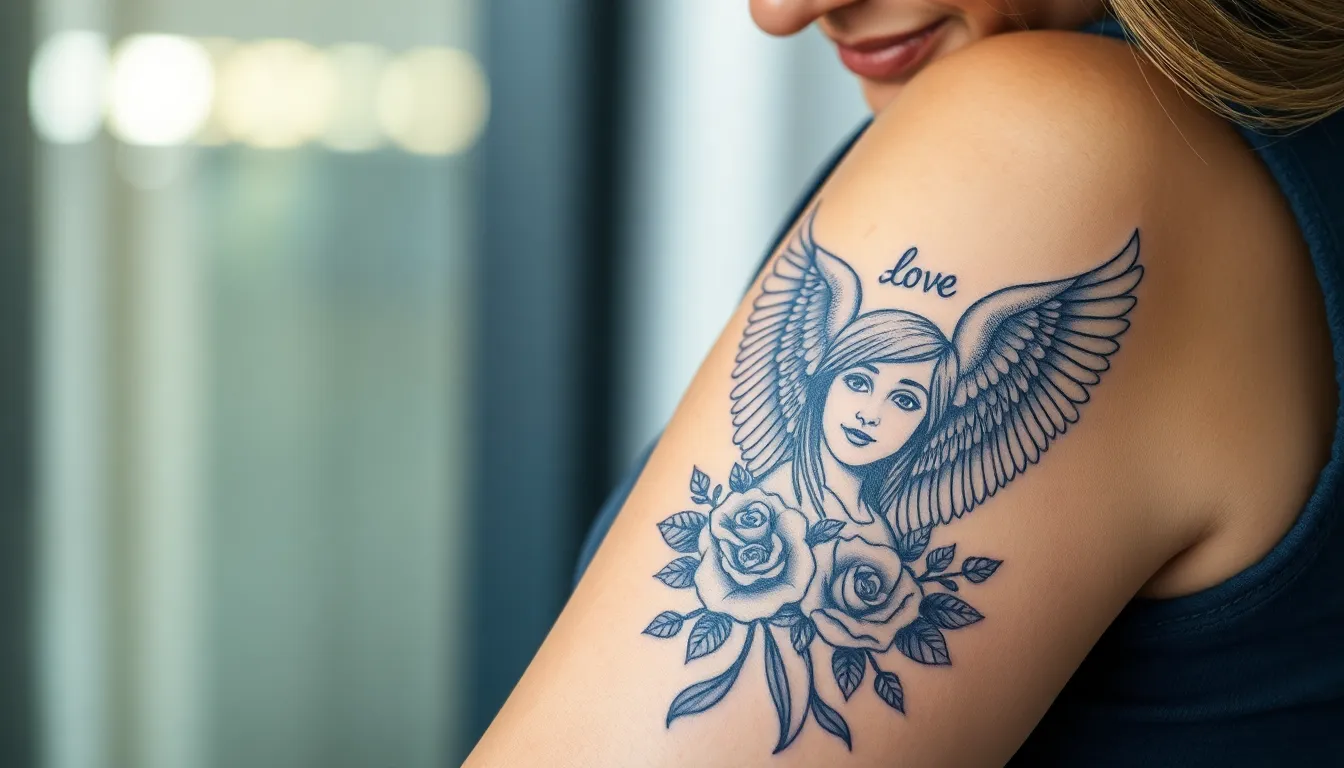
Memorial tattoos transform grief into permanent tributes, creating lasting connections between the living and those we’ve lost. These designs capture both the beauty of remembrance and the deep ache of absence.
Portrait Combinations with Symbolic Elements
Combining portraits with meaningful symbols creates powerful memorial pieces that tell complete stories of love and loss. Photos surrounded by roses represent the beauty and fragility of life, with single long-stemmed roses or full bouquets often colored to match the deceased’s favorite hue or recall a special memory. Angelic imagery adds spiritual depth to portrait tattoos, incorporating halos or wings to symbolize protection or ascension to heaven.
Creative combinations can include stars, moons, or birds integrated around portrait work to enhance personal meaning. Feathers or flowers woven into the design create unique memorial pieces that speak to individual relationships. Many choose to blend realistic portraiture with watercolor elements, allowing colors to bleed beyond traditional lines much like memories that flow through our daily lives.
Dates and Names with Grief Imagery
Birth and death dates serve as powerful reminders of a person’s complete life span, marking the beginning and end of their earthly journey. Names combined with infinity symbols represent endless love and connections that transcend death, often incorporating hearts or birds into the design to enhance their meaning. Grief imagery surrounding these personal details can include wilted flowers, broken chains, or empty spaces that symbolize absence.
Typography choices matter significantly when incorporating dates and names, with many opting for script fonts that mirror the deceased’s handwriting. Memorial dates can be woven into larger symbolic designs like tree branches, where each important date becomes a leaf or bloom. Simple name placements alongside meaningful symbols like stars create subtle yet profound tributes that carry deep personal significance.
Angel Wings and Heaven References
Angel wings symbolize protection and guardianship from beyond, often depicted as feathered and spread wide to represent the deceased watching over loved ones. Wings can be designed as standalone pieces or incorporated into larger memorial compositions, creating powerful visual metaphors for spiritual ascension. Heavenly imagery offers comfort through scenes representing the afterlife or peaceful places where we believe our loved ones now reside.
Cloud formations with breaks of light streaming through represent hope and divine presence during dark times of grief. Biblical verses or spiritual quotes can be incorporated alongside wing designs, creating layered meaning within single tattoo pieces. Some choose realistic feather details within wing designs, while others prefer stylized interpretations that focus on the emotional impact rather than anatomical accuracy.
Mental Health Awareness Pain Tattoo Concepts
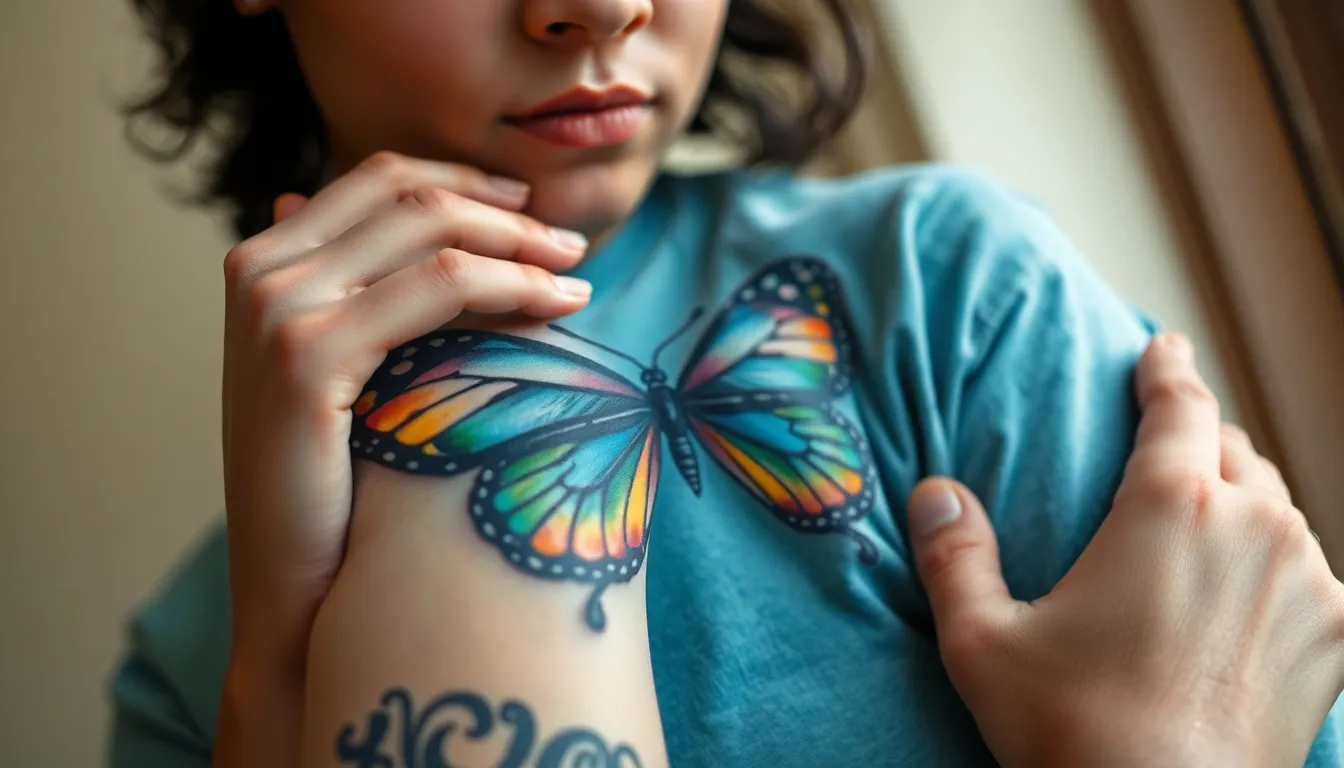
Mental health struggles create some of the most meaningful tattoo designs, transforming internal battles into visible symbols of hope and survival. We’ve seen how these powerful pieces help people reclaim their stories while raising awareness about mental health challenges.
Semicolon and Continuation Symbols
Semicolon tattoos represent the decision to continue even though adversity, often associated with mental health struggles like depression and anxiety. Writers use semicolons when they could end a sentence but choose to continue instead, making this punctuation mark a perfect metaphor for choosing life over despair. We often see these designs paired with inspirational words like “my story isn’t over yet” or combined with other meaningful symbols.
Infinity symbols create powerful representations of endless possibilities and hope during mental health challenges. These flowing designs remind us that recovery is an ongoing journey with unlimited potential for growth and healing. Many people incorporate dates, names, or small details within the infinity loop to personalize their mental health awareness tattoos.
Combination designs featuring both semicolons and infinity symbols offer layered symbolism that speaks to continuous hope and perseverance. These paired elements create visually striking pieces that communicate complex emotions about mental health recovery and ongoing strength.
Brain Imagery with Cracks or Repairs
Cracked brain tattoos represent the journey of healing and recovery from mental health issues, showing how our minds can be both fragile and resilient. These designs often feature visible fractures that are being mended with gold, silver, or colorful thread, drawing inspiration from the Japanese art of kintsugi. We see these tattoos as powerful reminders that our broken places can become our strongest features.
Anatomical brain designs with repair elements showcase the medical and artistic aspects of mental health recovery simultaneously. Stitches, bandages, or blooming flowers growing from cracks transform clinical imagery into hopeful artistic statements. These detailed pieces often incorporate neural pathways or synapses to highlight the complexity of mental health healing.
Abstract brain representations with healing motifs offer more interpretive approaches to mental health awareness tattoos. Watercolor effects, geometric patterns, or mandala elements can represent the mind’s healing process without literal medical imagery, creating beautiful pieces that spark conversations about mental health.
Butterfly Transformation Designs
Butterfly tattoos symbolize transformation and growth, often used to represent overcoming mental health challenges through their powerful metamorphosis imagery. These designs capture the journey from struggle to strength, showing how we can emerge from our darkest moments more beautiful and resilient. We frequently see butterflies incorporated with semicolons, infinity symbols, or meaningful quotes about mental health recovery.
Emerging butterfly designs show the transformation process in action, with wings partially formed or breaking free from cocoons to represent ongoing mental health healing. These ever-changing pieces remind us that recovery isn’t instant but rather a gradual process of becoming our authentic selves. Watercolor techniques often enhance these designs, creating fluid, ethereal effects that mirror the delicate nature of mental health progress.
Multi butterfly collections represent different stages of mental health awareness and recovery, with each butterfly symbolizing a exact challenge overcome or milestone reached. These comprehensive designs can include various butterfly species, sizes, or colors to tell complete stories of mental health journeys and personal growth through artistic expression.
Physical Pain and Healing Tattoo Ideas
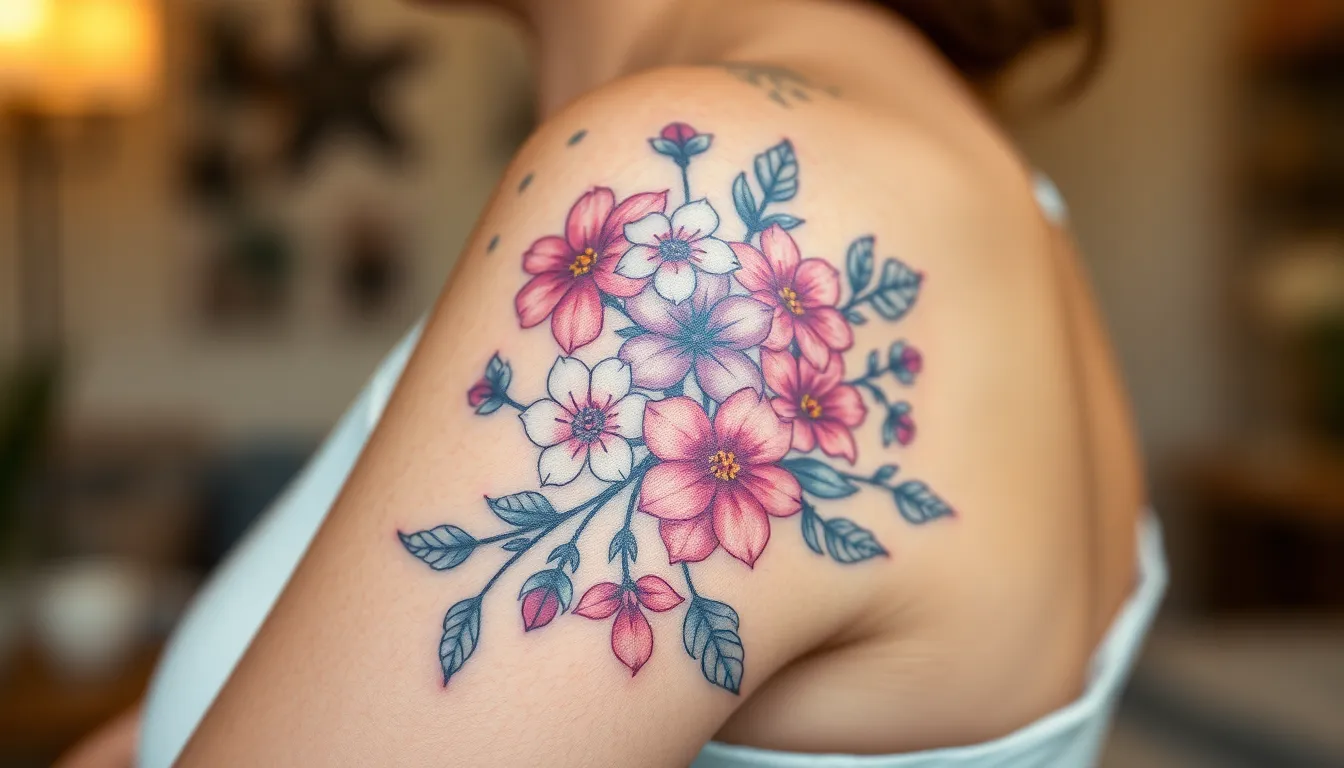
Physical pain experiences often inspire the most meaningful tattoo transformations. We find that these designs celebrate resilience while honoring the journey through medical challenges and recovery.
Surgical Scar Cover-Up Designs
Surgical scar cover-ups transform medical reminders into beautiful artwork. Floral tattoos offer the most popular solution for mastectomy scars, using delicate flowers and leaves to seamlessly blend scar tissue into natural designs. Animal designs like foxes and mushrooms create whimsical transformations for thigh scars, turning surgical marks into playful artwork.
Long surgical scars work perfectly with branch and leaf designs. These organic patterns incorporate the scar’s natural lines into flowing botanical elements. We’ve seen remarkable transformations where surgical incisions become tree branches, creating stunning visual narratives of growth through adversity.
Watercolor techniques add depth to scar cover-ups by blending colors around the surgical site. Artists use soft gradients to create dreamy backgrounds that make scars disappear into artistic compositions.
Medical Symbol Interpretations
Medical symbols in tattoos carry powerful healing meanings. The Caduceus represents medicine and healing, making it perfect for healthcare workers or those celebrating medical recoveries. We recommend incorporating personal elements like dates or names to customize these traditional symbols.
Red Cross tattoos symbolize medical care and first aid, often chosen by emergency responders or those who’ve experienced life-saving medical interventions. These designs work well as standalone pieces or incorporated into larger healing narratives.
Stethoscope designs transform medical tools into artistic expressions. Healthcare professionals often choose these tattoos to honor their calling, while patients use them to celebrate their healing journey.
DNA helix patterns represent the fundamental building blocks of life and healing. These scientific symbols appeal to those who appreciate both medical science and personal transformation through medical challenges.
Bandage and Healing Motifs
Bandage motifs symbolize active healing processes in tattoo form. Bandaged heart designs represent emotional healing, often featuring realistic medical tape wrapped around anatomical hearts. We see these paired with dates marking important recovery milestones.
Healing hands tattoos showcase care and support through medical journeys. These designs often feature hands reaching toward light or cradling symbolic elements like flowers or hearts.
Stitch patterns transform surgical realities into artistic statements. Cross-hatch designs mimic medical sutures while creating geometric beauty, perfect for those who want to honor their surgical experiences.
Thermometer tattoos capture the fever and recovery aspects of illness. Artists often incorporate temperature readings that mark important health milestones or recovery dates.
Medical chart elements like heartbeat lines create ever-changing linear designs. These EKG patterns work beautifully as wraparound pieces or integrated into larger healing narratives.
Minimalist Pain Tattoo Approaches
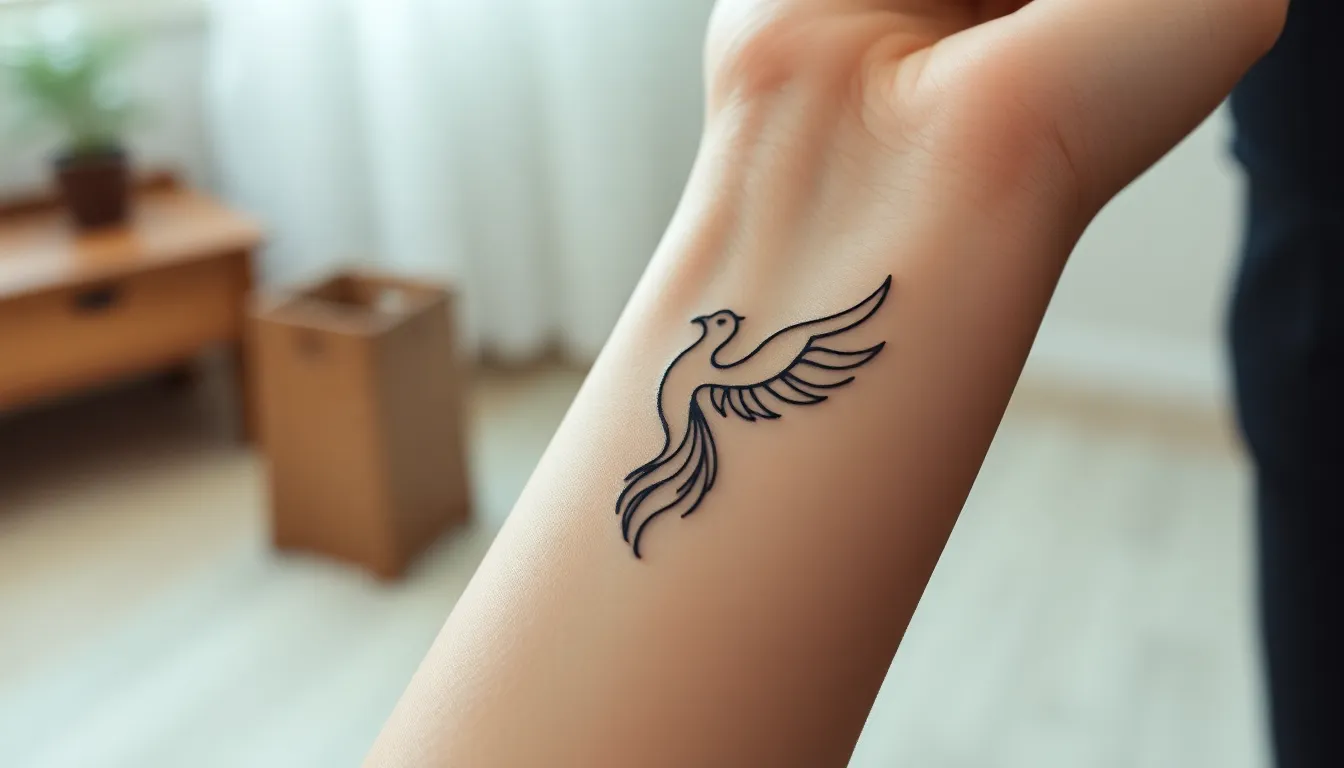
Minimalist designs offer powerful ways to express personal struggles without overwhelming visual complexity. We find that these understated approaches create meaningful body art that resonates deeply while maintaining elegant simplicity.
Simple Line Art Representations
Minimalist line art creates symbols that represent pain through clean, powerful imagery. Artists use single continuous lines to form arrows that pierce through emotional barriers or minimalist skulls that acknowledge mortality and struggle. These designs communicate profound meaning through their stark simplicity.
Geometric shapes transform abstract concepts of pain into visual representations. Triangles pointing downward can symbolize emotional weight, while circles with deliberate breaks represent life’s interruptions. We see these shapes incorporating subtle details like tiny cracks or incomplete lines that convey deeper meaning about personal challenges.
Single stroke designs capture the essence of transformation through adversity. Phoenix outlines rising from simple flame shapes create powerful metaphors for rebirth after pain. These line art pieces work exceptionally well on wrists, ankles, or behind ears where their delicate nature shines.
Single Word Expressions
Using a single word like “pain” or “struggle” in minimalist typography creates direct, honest statements. Clean sans serif fonts or delicate script lettering transform these powerful words into permanent reminders of personal experiences. We recommend choosing fonts that reflect your personality while maintaining readability over time.
Short phrases like “still standing” convey resilience through concise messaging. Two or three word combinations pack emotional punch without requiring large tattoo spaces. Phrases such as “breathe through” or “keep going” serve as daily mantras for those handling ongoing challenges.
Foreign language expressions add layers of personal meaning to word based tattoos. Latin phrases like “dolor hic tibi proderit olim” meaning “this pain will benefit you someday” offer classical elegance. We find that choosing languages connected to your heritage or personal journey enhances the tattoo’s significance.
Small Symbol Combinations
Combinations of symbols such as snakes and daggers represent overcoming pain through powerful imagery. Snakes symbolize transformation and healing while daggers represent the cutting away of negative experiences. These paired elements create narratives about conquering personal demons.
Minimalist animal figures like birds or bees represent hope and recovery from suffering. Small bird silhouettes flying upward symbolize freedom from past trauma. Bee designs honor the concept that sweetness comes after enduring life’s stings, creating optimistic reminders of growth.
Nature elements such as trees or mountains symbolize strength through adversity. Minimalist tree designs with deep roots represent grounding during difficult times, while small mountain outlines remind us that challenges can be overcome. These natural symbols connect personal struggles to universal themes of growth and endurance.
Color Psychology in Pain Tattoo Designs
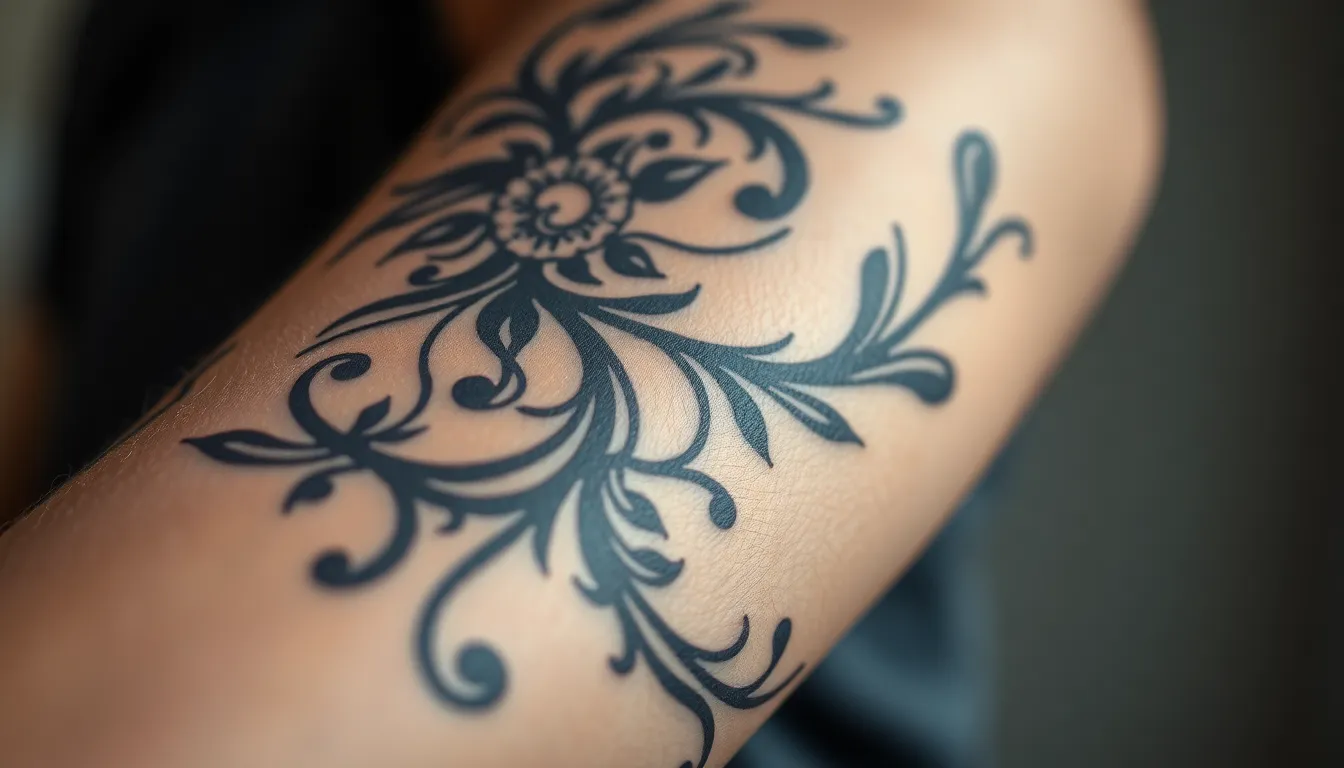
Color choices in pain tattoos dramatically impact their emotional resonance and symbolic meaning. Understanding how different hues affect perception helps create more powerful and personally meaningful designs.
Black and Gray Emotional Depth
Black and gray tattoos offer the most profound way to convey emotional depth and resilience in pain inspired designs. These monochromatic palettes naturally represent the struggle while simultaneously showcasing the ability to overcome adversity. Traditional black work creates striking contrasts that emphasize the weight of personal battles, making each design element feel more substantial and permanent.
Gray shading adds nuanced emotional layers that capture the complexity of healing journeys. Darker grays can represent the depths of despair, while lighter tones symbolize hope emerging from darkness. Artists often use gradient techniques to show the transition from pain to recovery, creating visual narratives that mirror internal transformation processes.
Professional tattoo artists frequently recommend black and gray for memorial pieces and trauma related designs because these colors age beautifully over time. The timeless quality of monochromatic work ensures that pain tattoos maintain their emotional impact for decades. Also, black and gray designs photograph well and reproduce clearly in various lighting conditions, making them ideal for meaningful body art.
Red Accents for Intensity
Red accents amplify the emotional intensity of pain tattoos by symbolizing passion, strength, and the fire of survival. Strategic placement of red elements can highlight exact aspects of struggle, such as bleeding hearts in memorial designs or crimson roses emerging from thorns. This color choice transforms subtle pain symbols into bold statements of resilience and determination.
Artists incorporate red to represent the raw intensity of emotional or physical trauma while maintaining the overall design’s aesthetic balance. Blood red shades work particularly well in anatomical heart tattoos, where they emphasize life force and vitality even though suffering. Watercolor bleeding effects using red tones create powerful visual metaphors for how pain spreads through our emotional industry.
Red highlighting works exceptionally well in combination with black and gray foundations, creating focal points that draw attention to key symbolic elements. Consider using red sparingly to maintain maximum impact, as too much can overwhelm the design’s subtlety. The color’s association with both pain and healing makes it perfect for tattoos that celebrate overcoming adversity.
Blue Tones for Melancholy
Blue tones capture the introspective and melancholic aspects of pain experiences, making them ideal for designs that represent sadness, loss, or deep emotional processing. These colors evoke feelings of calm reflection while acknowledging the depth of sorrow that accompanies important struggles. Navy blues and midnight shades work particularly well for memorial tattoos and designs honoring lost loved ones.
Lighter blue tones can represent the peaceful resolution that comes after working through pain, similar to clear skies after storms. Watercolor techniques using various blue shades create flowing, organic designs that mirror the way emotions ebb and flow during healing processes. Artists often blend blues with purples to create twilight effects that symbolize transition periods between pain and recovery.
Ocean inspired blue tattoos connect personal pain to universal themes of depth and mystery, while sky blues can represent hope and endless possibilities beyond current struggles. The cooling effect of blue tones provides emotional balance in designs that might otherwise feel too intense or overwhelming. These colors age gracefully and maintain their symbolic power throughout the tattoo’s lifetime.
Placement Considerations for Pain Tattoo Ideas
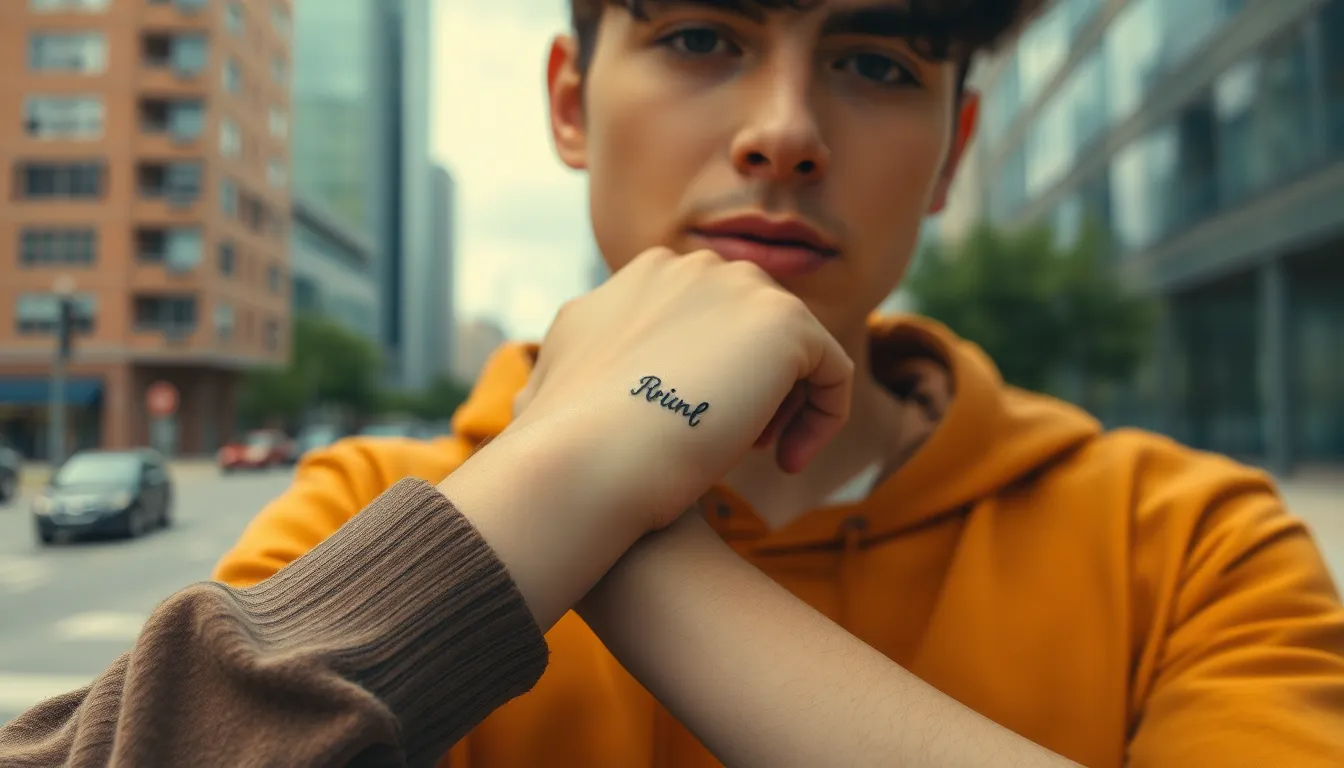
Choosing the right placement for your pain tattoo amplifies its emotional impact and personal significance. Strategic placement decisions help balance visibility with meaning while considering your pain tolerance and lifestyle needs.
Visible Areas for Statement Pieces
Chest tattoos command attention and exude confidence while positioning your pain narrative close to your heart. We find that big chest tattoos serve as powerful statement pieces that symbolize the importance of your personal struggles. This placement allows you to share your story openly when you choose to do so.
Wrist placements offer high visibility for marking important events or covering existing scars from past struggles. While wrist tattoos involve considerable pain during the process, they create constant reminders of your resilience that you’ll see throughout each day. We recommend this area for smaller designs that hold deep personal meaning.
Back tattoos indicate stability and strength while offering the flexibility of easy concealment when needed. Large back pieces provide extensive canvas space for complex pain narratives that incorporate multiple symbolic elements. This placement works exceptionally well for those who want the option to keep their tattoos private in professional settings.
Hidden Locations for Personal Meaning
Ribcage placements accommodate larger, intricate designs that remain completely hidden under clothing. We’ve observed that ribcage tattoos allow for meaningful phrases or detailed artwork that serves as private reminders of your journey. The moderate to high pain level during tattooing often mirrors the emotional significance of the design itself.
Inner ankle locations suit small, discrete designs that can be easily concealed with socks or pants. This placement offers versatility for those who need complete concealment options while maintaining easy personal access to view the tattoo. We find inner ankle tattoos particularly effective for minimalist pain symbols or single words.
Collarbone areas provide elegant placement options for small, intricate designs with moderate pain levels. This location offers a unique aesthetic that remains easily concealable while creating an intimate connection between your pain narrative and your heart center. Collarbone tattoos work beautifully for memorial designs or healing symbols.
Size Recommendations by Body Part
| Body Part | Recommended Size | Design Complexity | Visibility Level |
|---|---|---|---|
| Inner ankle | Small (1-3 inches) | Simple to moderate | Easily hidden |
| Collarbone | Small to medium (2-4 inches) | Moderate to intricate | Partially visible |
| Wrist | Small (1-2 inches) | Simple | Highly visible |
| Ribcage | Medium to large (4-8 inches) | Complex | Completely hidden |
| Back | Large (6+ inches) | Very complex | Easily concealed |
| Chest | Medium to large (4-8 inches) | Moderate to complex | Statement visible |
Small designs work best on inner ankles, collarbone areas, and behind the ear where space constraints require focused symbolism. These locations excel for single words, minimalist symbols, or small memorial dates that carry maximum impact through simplicity.
Medium to large designs thrive on ribcage and back placements where expansive canvas space allows for complex storytelling. We recommend these areas for detailed pain narratives that incorporate multiple elements like healing imagery, memorial portraits, or abstract representations of your journey through adversity.
Conclusion
Pain tattoo ideas offer us profound ways to transform our deepest struggles into meaningful works of art. Whether we’re drawn to symbolic representations or prefer minimalist approaches these designs serve as permanent reminders of our strength and resilience.
The beauty of pain-inspired tattoos lies in their deeply personal nature. From memorial pieces honoring lost loved ones to mental health awareness symbols each design tells a unique story of survival and growth.
We’ve explored countless possibilities from abstract watercolor effects to literary quotes that capture our experiences. The key is choosing elements that truly resonate with our individual journey through adversity.
Remember that thoughtful placement and color choices can significantly enhance your tattoo’s emotional impact. Whether you opt for visible statement pieces or more private placements these designs will serve as lasting testaments to your courage and determination to overcome life’s challenges.
Frequently Asked Questions
What do pain-inspired tattoos symbolize?
Pain-inspired tattoos symbolize resilience, survival, and personal growth through adversity. They serve as permanent reminders of challenges overcome, whether physical or emotional. These tattoos transform struggles into visual narratives that celebrate strength and healing, helping individuals honor their journey while creating meaningful body art that represents their ability to persevere through difficult times.
What are popular symbolic designs for pain tattoos?
Popular symbolic designs include broken hearts with jagged cracks representing emotional trauma, thorns and roses symbolizing beauty emerging from suffering, and anatomical hearts with visible scars. Other meaningful symbols include semicolons for mental health awareness, butterfly transformations, phoenix imagery for rebirth, and memorial elements like angel wings to honor lost loved ones.
How do watercolor tattoos represent emotional pain?
Watercolor bleeding effects create powerful representations of emotional pain by using blended colors to symbolize how trauma spreads throughout life. The flowing, organic nature of watercolor techniques visually captures the way emotional wounds affect multiple aspects of our existence, creating artistic interpretations that beautifully express the complexity and reach of internal suffering.
What quotes work well for pain-inspired tattoos?
Meaningful quotes include “Pain nourishes courage,” “With pain comes strength,” and “What doesn’t kill you makes you stronger.” Poetry excerpts and literary references that resonate with themes of suffering and resilience also work well. These words serve as permanent reminders of personal growth through adversity and can be integrated into designs using typography that reflects personal significance.
How can tattoos help with mental health awareness?
Mental health awareness tattoos transform internal battles into visible symbols of hope and survival. Semicolon tattoos represent choosing to continue despite adversity, while infinity symbols convey endless possibilities during challenges. Butterfly designs symbolize transformation from struggle to strength, and cracked brain tattoos represent healing journeys, often incorporating kintsugi-inspired artistic elements for added meaning.
What are good cover-up tattoo ideas for surgical scars?
Surgical scar cover-ups can transform medical reminders into beautiful artwork. Floral tattoos work well for mastectomy scars, while botanical elements can integrate long surgical scars into flowing designs. Watercolor techniques add depth to scar cover-ups, and whimsical animal designs can transform thigh scars into meaningful art that celebrates healing and recovery.
Are minimalist pain tattoos effective?
Yes, minimalist pain tattoos offer powerful expression through elegant simplicity. Single-stroke designs like phoenix outlines symbolize rebirth, while geometric shapes convey abstract pain concepts. Simple line art, single meaningful words, and small symbol combinations like snakes and daggers create direct statements of resilience while maintaining clean, timeless aesthetics that resonate deeply.
How does color psychology affect pain tattoos?
Color psychology dramatically impacts emotional resonance in pain tattoos. Black and gray convey emotional depth and resilience, with gray shading representing healing complexity. Red accents amplify emotional intensity and symbolize strength, while blue tones capture melancholic aspects of pain and evoke calm reflection. Strategic color choices enhance the overall impact and symbolic meaning.
Where should I place a pain-inspired tattoo?
Placement depends on personal preference and desired visibility. Visible areas like the chest and wrist work for statement pieces, while hidden locations like the ribcage and inner ankle offer more personal meaning. Small designs work best in discreet locations, while medium to large designs thrive on the ribcage and back, allowing for complex storytelling and detailed artwork.
How do memorial pain tattoos honor lost loved ones?
Memorial pain tattoos transform grief into permanent tributes by combining portraits with symbolic elements like roses or angel wings. Including birth and death dates, names, and personal handwriting creates deeper connections. Angel wings and heavenly references symbolize protection and spiritual connection, while grief imagery integrated with artistic elements creates profound expressions of love and remembrance.
